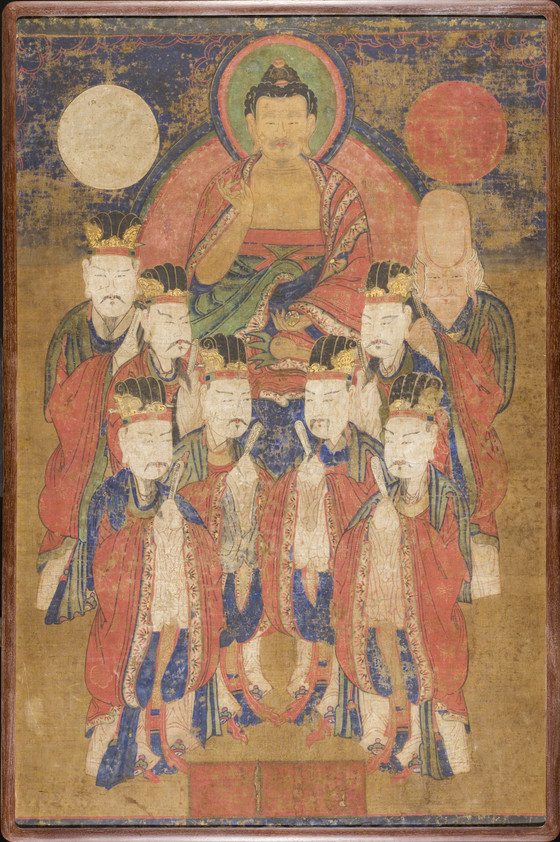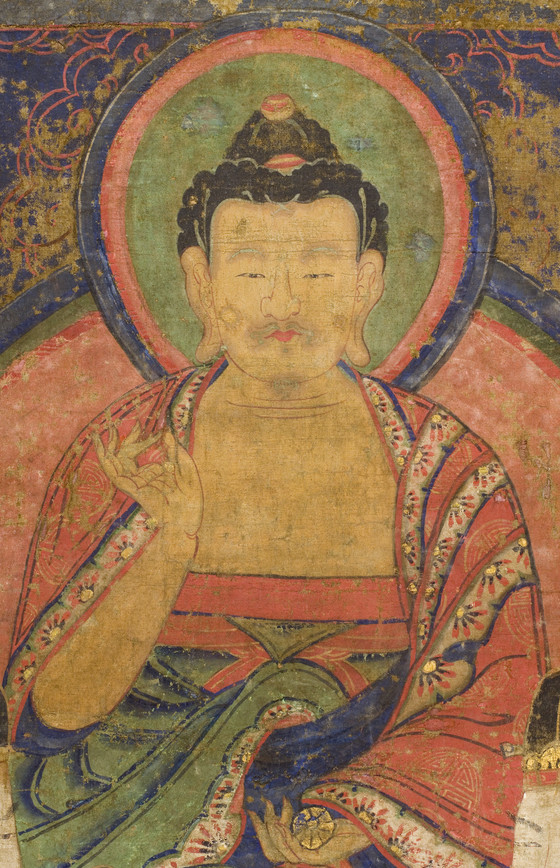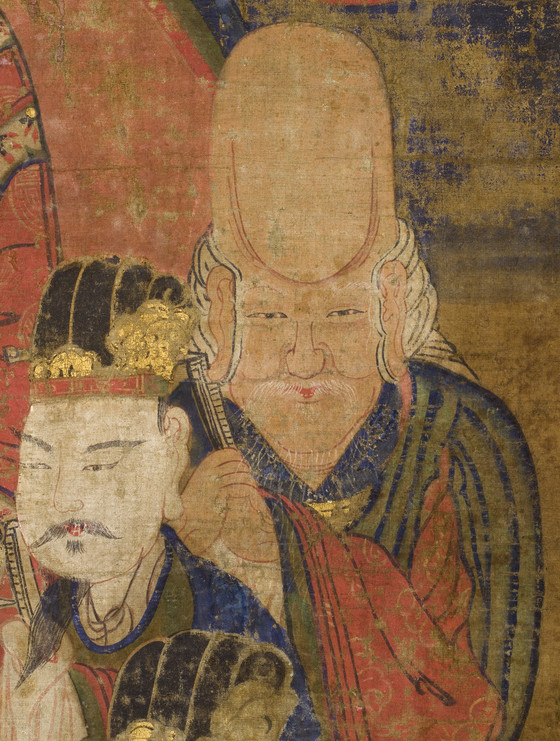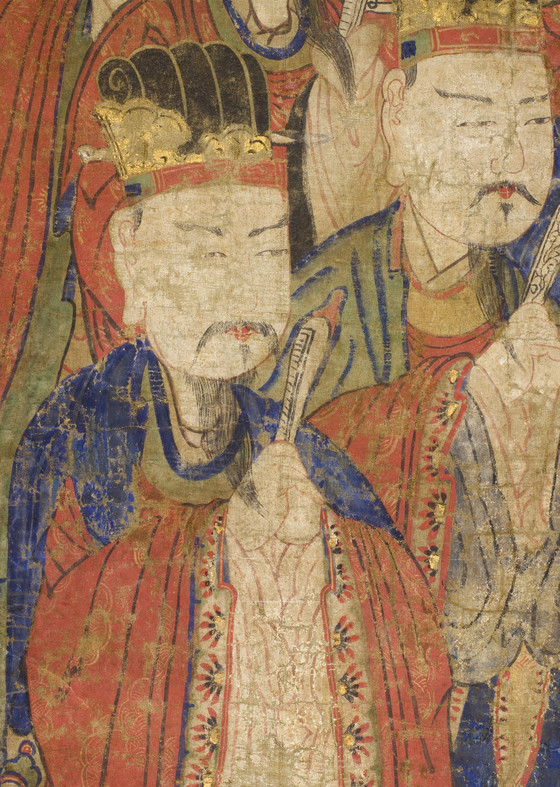Curator Notes
Since ancient times, travelers have used Polaris, or the North Star, as their guide. In Korea, Polaris was personified as the Buddha of Polaris (Chiseonggwang Yeorae); his attendants are the Buddhas of the Big Dipper (Chilseong Yeorae). This painting depicts the Buddha of Polaris surrounded by the Buddhas of the Big Dipper; all these deities entered the Buddhist pantheon when Korean folk religions mingled with Buddhism.
Paintings of the Buddhas of the Big Dipper were very popular in Korea. They can be found in almost all Korean Buddhist temples, where they are placed in shrines called the Big Dipper Pavilion (Chilseonggak) or the Three Stars Pavilion (Samseonggak). In Korean folk religion, the Big Dipper was believed to guide the sins and mishaps of human beings and ward off disasters, and to be a symbol of longevity. It was also thought to aid in the conception of a baby boy and, during the Joseon dynasty, the Big Dipper became widely revered by women who desired a son.
Similarly, the Buddha of Polaris – a Buddhist manifestation of this folk belief – was worshipped to avert disaster, grant wishes and longevity, and ensure prospering offspring. He was also believed to possess healing powers similar to those of the Buddha of Medicine (Yaksa Yeorae); in fact, two of his attendants – the bodhisattva of Sunlight (Ilgwang) and the bodhisattva of Moonlight (Wolgwang) – are also attendants of the Buddha of Medicine. According to many Buddhist sutras, the Buddha of Polaris holds a golden wheel and sits on a throne supported by seven lions. His body emits an infinite light that turns into great fire, with which he oversees the changes of the sky and rules over people’s wishes.
In Korea, there are two standard formats for the depiction of these deities. One format depicts the Buddha of Polaris and all his attendants together in a single painting, as seen in a large painting of the Buddha of Polaris and his attendants from 1892 in Goun Temple, North Gyeongsang province (fig. 1). The other format features[1] a set of individual paintings for each deity, or for two or three deities, with the Buddhas of the Big Dipper arranged on either side of a central painting of the Buddha of Polaris (see the essay for M.2000.15.1-.2). This painting is clearly an example of the former. The Buddha of Polaris, in the center, sits on a platform in a full lotus position. The large nimbus surrounding him is intended to represent rays of light radiating from his body. In his left hand, he holds a golden wheel (det. 1). He makes the vitarka gesture (the right hand faces upward and the middle figure and thumb touch; the left hand, facing upward, rests on the left leg, and again the fingers touch).The sun in the upper right and the moon in the upper left are symbolic representations of the bodhisattvas of Sunlight and Moonlight.
It is interesting to note that here, the figures surrounding the main Buddha are shown in their Daoist, rather than their Buddhist, personifications.[2] To the left of the Buddha of Polaris, and underneath the sun, is Taesangnogun, who is depicted as a Daoist hermit (det. 2). Taesangnogun’s role was that of a messenger: He preached the Dharma to human beings and related earthly affairs to the deities. The remaining seven figures of the Buddhas of the Big Dipper are also depicted in their Daoist personifications. They wear the gilded hats of officials and hold scepters (det. 3). Daoist iconography became more prevalent and more prominent in Korean art during the nineteenth and twentieth centuries. Its presence is a distinctive feature of Korean paintings of the Buddha of Polaris;[3] it also indicates that Korean Buddhism actively embraced Daoism at this period.
The inscription at the bottom records the names of the people who sponsored the production of the painting. While the date of the painting is not given, the Daoist iconography, the attire of the personifications of the Big Dipper, the use of gold on their hats, and the navy blue on the background stylistically place the work within the late nineteenth and early twentieth century.
Footnotes
[1] There is an example from 1877 in Cheonggok Temple in South Gyeongsang province.
[2] In Buddhism, Polaris and the Big Dipper are personified as the Buddha of Polaris attended by the Buddhas of the Big Dipper; in Daoism, Polaris is called Jamidaeje and the Big Dipper is Chilwon seonggun. LACMA’s painting depicts the Daoist rather than the Buddhist personifications.
[3] Another example of a painting of this type, from 1860, is in Sudo’am of Neungga Temple in Suncheon, South Jeolla province.
Bibliography
Buddhist Cultural Properties Research Institute. Korean Buddhist Painting [Hanguk ui bulhwa], vol. 1-40. Yangsan, Korea: Buddhist Cultural Properties Research Institute, 1996-2006.
Cha, Jae-seon. “Study of Buddhist Chilseong Paintings in the Joseon Dynasty [Joseonjo Chilseong Taenghwa ui Yeongu].” Master’s thesis, Dongguk University, 1987.
Kang, Mingi, et al. Understanding Korean Art Culture [Hanguk misul munhwa ui ihae]. Seoul: Yegyeong, 1994.
Kang, So-hyeon. “Buddhist Chilseong Paintings of the Joseon Dynasty [Joseon sidae ui Chilseong Taenghwa].” Master’s thesis, Seoul National University, 1998.
Mun, Myeongdae. Korean Buddhist Painting [Hanguk ui bulhwa]. Seoul: Yeolhwa-dang, 1977.
More...



